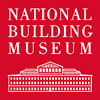  |
 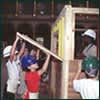 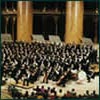 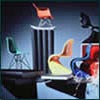 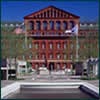  |
Hours and Admission
The National Building Museum is open to the public Monday - Saturday, 10 am to 5 pm, and Sunday, 11 am to 5 pm. The Museum is closed Thanksgiving, Christmas, and New Year's Day. On rare occasions, the Museum may close for a special event.Admission is free. A donation of $5 per person is suggested.
Getting Here
The National Building Museum is located at 401 F Street NW, between 4th and 5th Streets, across the street from the Judiciary Square Metro (Red Line). Wheelchair access is available through the G Street entrance.The Museum does not provide parking. Metered parking is located on 5th, F, and G Streets. Nearby parking lots/garages are located at the MCI Center's 6th Street entrance and at the corner of 7th and H Streets.
Walk-In Tours at the National Building Museum
Discover one of Washington's most spectacular structures and experience what people from all over the country are talking about."I love the expression of surprise that registers on visitors' faces when they enter the Museum. The interior space never ceases to delight and awe my tour clients, and the wonderful exhibits offer an unexpected learning pleasure. The National Building Museum is an experience!"
—Jeanne Fogel, owner of A Tour de Force: Guided Tours of Washington, D.C.Walk-In Building Tours
Informative, fascinating tours of the Museum’s historic home are offered daily by Museum docents. Constructed of more than 15 million bricks, the Museum houses some of the largest Corinthian columns in the world and has been the site of sixteen Presidential Inaugural balls, from Grover Cleveland's in 1885 to George W. Bush's in 2004.Tours last 45 minutes and are offered Monday through Wednesday at 12:30 pm, and Thursday through Sunday at 11:30 am, 12:30 pm, and 1:30 pm.
No reservations are required for groups fewer than 10.
Exhibition Highlights Tours
Highlight tours of the Museum’s long-term and temporary exhibitions are offered on Friday, Saturday, and Sunday at 2:30 pm.No reservations are required for groups fewer than 10.
Discovery Carts
Arches and Trusses: The Tension Builds
every Sunday 2:30—3:00 pm
Discover how building forces, materials, and structures give buildings strength and longevity. Participants test different building materials and work together to construct an arch and a truss.
Bridging the Gap
every Saturday, 2:30—3:00 pm
Participants learn about five bridge types before solving a community's transportation problem by choosing a new bridge to build.Cityscapes Revealed: Highlights from the Collection
December 3, 2005 / Long termThis first-ever retrospective exhibition of the National Building Museum’s unique collection explores quintessentially American, 20th-century buildings from center-city mansions to main street storefronts and sleek downtown skyscrapers. Anchored by a series of large architectural elements, this walking tour of the cityscape is complemented by exquisitely detailed drawings; rare, early-20th-century photographs; and smaller-scale fragments from National Historic Landmarks—including the former U.S. Pension Building, the Museum’s extraordinary home.
Established in 1977, the Museum’s permanent collection holds a wealth of artifacts that illuminate virtually all aspects of America’s building heritage. This exhibition highlights the collection’s strength, namely the building materials, architectural styles, and construction practices that defined urban America from the end of the 19th through the first half of the 20th centuries.
Cityscapes Revealed affords close-up views of building details not otherwise seen. Some, such as the terra-cotta rosettes originally installed as part of the Museum’s cornice, are far above eye level. Others, such as the watercolors rendered by interior designer Ernest L. Brothers, are part of the design or construction process. And still others are so common or seemingly mundane, such as brick bonding patterns, that hardly anyone takes notice, much less stops to examine them. By focusing on these details and many others, the exhibition draws attention to the imagination of the designer, the skill of the craftsman, the hand of the contractor, and the eye of the photographer—underscoring the myriad complexities of building and the importance of both individual talent and collaborative relationships. Though always present, these forces are sometimes easier to see and appreciate in buildings from the past.
Even the keenest observers of the city make “new” discoveries, in plain sight, all the time. After taking this tour of the National Building Museum’s collection, we encourage you to undertake your own explorations of the city.
UPCOMING LECTURES AND TOURS
Scully Prize Presentation
Phyllis Lambert: Ironies in the Public Life of Architecture: The Seagram Building, 1954 – 58
Thursday, January 19
6:30–8:00 pm
Over the past 50 years, Phyllis Lambert — architect, author, educator, activist, and philanthropist — has made outstanding contributions to the design of the built environment, advancement of public awareness of design, and architectural preservation. Early in her career, she served as the director of planning for the Seagram Building, the Mies van der Rohe masterpiece. On the occasion of receiving the Museum's Vincent J. Scully Prize, Ms. Lambert will give a lecture about the public reception and long-term impact of the Seagram Building on architectural culture. •1.5 CEU
$12 Members and students; $17 nonmembers. Prepaid registration required.
Registration has ended for this program. Tickets will be available at the door beginning at 5:30 pm.Spotlight on Design
Davis Brody Bond/Max Bond
Monday, January 23
6:30–8:00 pm
In July 2004, the architecture firm Davis Brody Bond was selected to complete the overall plans for “Reflecting Absence,” the World Trade Center Memorial in New York designed by Michael Arad, AIA and Peter Walker, FASLA. A founding principal of the New York-based firm, J. Max Bond, Jr., FAIA will discuss this central piece of the WTC site as well as his firm's other notable projects, including Atlanta's Martin Luther King, Jr., Center for Nonviolent Social Change, and the Birmingham Civil Rights Institute. •1.5 CEU
$12 Museum members; $17 nonmembers; $10 students. Prepaid registration required.
Registration has ended for this program. Tickets will be available at the door beginning at 5:30 pm.Building in the 21st Century
Energy Efficiency Tax Incentives in the Energy Policy Act of 2005: Where Are the Biggest Opportunities for Saving Energy?
Tuesday, January 24, 2006
12:30–1:30pm
Steven Nadel, executive director of the American Council for an Energy-Efficient Economy, will discuss the various tax incentives for saving energy in the recently enacted Energy Policy Act of 2005 which include incentives for high efficiency new homes, commercial buildings, heating and cooling equipment, appliances, solar, fuel cell and micro turbine systems, and for upgrades to existing building shells and commercial lighting systems. The talk will provide an update on implementing regulations for these provisions, and will discuss where the biggest opportunities for savings are, both from the point of view of the country, as well as for individual consumers and businesses. •1.0 HSW CEU
Free. Registration not required.Lecture
Heavyweight Transparency: Architecture with LiTraCon
Tuesday, January 24
Reception: 6:00–7:00 pm
Program: 7:00–8:30 pm
LiTraCon (Light-Transmitting Concrete) is a revolutionary product that brings translucence to a traditionally opaque material. Hungarian architect Áron Losonczi, the inventor of LiTraCon, will discuss its evolution and use in various projects, including Europe Gate 2004. This program complements the exhibition Liquid Stone: New Architecture in Concrete, which will be open for viewing, and features a five-foot tall LiTraCon wall. A reception precedes the program. This event is supported by the Embassy of Hungary in Washington, D.C. •1.5 CEU
$12 Museum members and students; $17 nonmembers. Prepaid registration required.
Registration has ended for this program. Tickets will be available at the door beginning at 6:00 pm.Spotlight on Design
Snøhetta: Craig Dykers
Wednesday, January 25, 2006
6:30–8:00 pm
The buildings of Snøhetta explore a smooth integration into the landscape through an innovative use of materials and forms. Craig Dykers, a founding principal of the Norwegian-based studio, will discuss some of the firm’s internationally-acclaimed projects including the Bibliotheca Alexandrina in Alexandria, Egypt, a recipient of the 2004 Aga Kahn Award for Architecture, the Turner Contemporary in Margate, England, and the National Opera House in Oslo. •1.5 CEU
$12 Museum members; $17 nonmembers; $10 students. Prepaid registration required.
Lecture
Rubble: Unearthing the History of Demolition
Thursday, January 26
6:30–8:00pm
From the straight boulevards that “demolition artist” Haussmann smashed through rambling old Paris to the televised implosion of Las Vegas casinos, demolition has played an ambiguous role in our lives. Author Jeff Byles will present a history of the little studied art and science of un-building and will discuss the nature of destruction as a prelude to renewal. After the lecture, he will sign copies of his book Rubble: Unearthing the History of Demolition (Harmony Books) •1.5 CEU
$10 Museum members and students; $15 nonmembers. Registration required.
Construction Watch Tour
GSA Federal Building
Saturday, January 28
10:00 am–12:00 pm
A major federal building designed by architect Moshe Safdie is currently under construction in the NOMA (North of Massachusetts Avenue) neighborhood of Washington. The agency headquarters includes a six-story, crescent-shaped wing and two rectilinear, eight-story wings connected by an atrium. Jean Hundley, project manager with the General Services Administration, will lead a tour of this 422,000-square-foot project. •2.0 HSW CEU
Open only to museum members, $18. Space is limited. Prepaid registration required.
This tour is sold out.Lecture
Architectural Designs for Early and Modern Washington, D.C.
Thursday, February 2
6:30–8:00 pm
Showing seldom-seen architectural drawings at the Library of Congress, C. Ford Peatross, the library's curator of architecture, design, and engineering collections, will discuss some of Washington's most important buildings, monuments, and memorials as well as anonymous structures of everyday life and ambitious projects that were never built. The drawings tell the sometimes surprising story of the capital's planning and growth over two centuries. After the lecture, he will sign copies of his edited volume Capital Drawings: Architectural Designs for Washington, D.C., from the Library of Congress (Johns Hopkins University Press). •1.5 CEU
$10 Members and students; $15 Nonmembers. Registration required.
Smart Growth
The State of Growth in the Commonwealth of Virginia
Thursday, February 2
12:30–1:30pm
For the past several years Virginia has experienced very rapid growth, particularly in northern Virginia. The consequences of this growth for traffic, school expenditures, and quality of life have brought growth issues to the forefront of Virginia's politics, where they were a key factor in last year's governor's race. Lately, the highly polarized discussion about growth has become more nuanced. Patrick McSweeney, former chairman of the Virginia Republican Party, will share his thoughts on the policy changes Virginia needs to make to better accommodate its rapid and continuing growth. •1.0 CEU
Free. Registration not required.Construction Watch Tour
Swiss Ambassador’s New Residence
Saturday, February 4
12:00–1:30 pm
A new residence for the Swiss Ambassador is nearing completion in Washington, D.C. Designed by New York architect Steven Holl and Swiss architect Justin Rüssli, the building’s cruciform shape is reminiscent of the cross in the Swiss flag and will provide spectacular views of the Washington Monument. Olaf Schmidt with Steven Holl Architects and Peter Ege with James G. Davis Construction will lead a tour of this nearly 14,000-square-foot project, scheduled for completion in May. •1.5 HSW CEU
Open only to Museum members, $18. Space is limited. Prepaid registration required.
This tour is sold out.Lecture
Greening the Built Environment in Response to Climate Change
Thursday, February 9
6:30–8:00 pm
The National Building Museum and the Koshland Science Museum (KSM) present a discussion by Tim Beatley, Teresa Heinz professor of sustainable communities, University of Virginia (UVA), and Bruce Hayden, professor and chair, department of environmental sciences at UVA, about green design concepts for homes and communities. They will examine the relationship of architecture and climate change, and specific design features that can diminish the potential impact of climate on the urban environment. •1.5 HSW CEUNote: This program will be held at the Koshland Science Museum, corner of 6th and E Streets, NW.
$12 Museum members, Friends of KSM, and students; $17 nonmembers. Prepaid registration required.
Office Tour
Toyota Government and Industry Relations Office
Saturday, February 11
10:00 am–12:00 pm
Toyota’s recently renovated Government and Industry Relations Office in Washington, D.C. reflects the automaker’s commitment to environmental excellence. Gensler associate Jill Goebel, IIDA, will lead a tour of this 25,000-square-foot sustainable workplace, which includes extensive use of natural light, locally quarried stacked stone walls, and veneer and substrates from managed forests. The project is one of the first in Washington to participate in the U.S. Green Building Council’s LEED Commercial Interiors certification program. •2.0 HSW CEU
Open only to museum members, $18. Space is limited. Prepaid registration required. To register, call the Museum or visit www.nbm.org beginning Thursday, January 26.Spotlight on Design
Antoine Predock, FAIA
2006 AIA Gold Medal Winner
Saturday, February 11
4:00–5:30 pm
The works of architect Antoine Predock, FAIA, respond in many ways to both the natural and the cultural landscapes in which they are built. Recipient of the 2006 American Institute of Architects Gold Medal, the internationally acclaimed architect draws inspiration from the elemental, historical, and mythical forces of a site. In this exclusive appearance, the Albuquerque, New Mexico-based architect will discuss his award-winning work.Following the lecture, Predock and Robert Ivy, FAIA, editor-in-chief of Architectural Record magazine, will discuss the designer’s philosophy and projects, including the Shadow House in Santa Fe; the Flint RiverQuarium in Albany, Georgia, and the San Diego Padres baseball stadium. After his lecture, he will sign copies of his books. This program is co-presented with the American Architectural Foundation (AAF) and the American Institute of Architects. •1.5 CEU
$15 Museum, AAF, and AIA members; $20 nonmembers; $10 students. Prepaid registration required.
D.C. Builds
Extending Modernism in the Monumental City
Monday, February 13
6:30–8:00 pm
Usually demonized as a failed 1960s urban renewal effort, Washington's Southwest neighborhood has an unappreciated fabric of modernist residential architecture. Last fall the Anacostia Waterfront Corporation (AWC) sponsored a design studio at the Harvard Graduate School of Design (GSD) to investigate the extension and redefinition of this architectural legacy in rebuilding the Southwest Waterfront. Inspired by this studio work, a panel of leading architects will discuss the role of modernism in a city largely characterized by monumental classicism and historic patterns of urbanism. Moderated by Toni L. Griffin, AWC vice president and director of design, the panel will include: Andrea Leers, GSD adjunct professor of architecture and urban design and principal of Leers Weinzapfel Associates; Marion Weiss, principal of Weiss/Manfredi Architects; Diana Balmori, founding principal of Balmori Associates and member of the U.S. Commission of Fine Arts; and Shalom Baranes, FAIA, founding principal of Shalom Baranes Associates. This program is co-sponsored with the AWC. •1.5 CEU
$12 Museum members and GSD alumni; $17 nonmembers; $10 students. Registration required.
Lecture
Engineering Large-Scale Structures
Tuesday, February 14
6:30–8:00 pm
For three decades Thornton-Tomasetti Group has devised creative engineering solutions for some of the world's iconic structures, from skyscrapers and stadiums to museums and airports. Charles H. Thornton, Ph.D., P.E., founding principal, former co-chairman, and now consultant, and Richard L. Tomasetti, P.E., Hon. AIA, chairman and founding principal, will explore the technical demands involved in creating large, complex buildings, including Petronas Towers in Malaysia, Taipei 101 (currently the world's tallest building) in Taiwan, Soldier Field in Chicago, and the Modern Art Museum of Fort Worth. Following their lecture, they will sign copies of the recent book Expressing Structure (Birkhäuser), surveying the firm's notable projects. •1.5 CEU
$10 Museum members and students; $15 nonmembers. Registration required.
Spotlight on Design
Moshe Safdie
Thursday, February 16
6:30–8:00 pm
Since his seminal Habitat project for Montreal's Expo '67, architect Moshe Safdie, FAIA, has designed richly geometric housing and mixed-use complexes, airports, public buildings, and cultural and educational facilities throughout the world. The principal of Moshe Safdie and Associates will discuss his recent museum designs, which include the Boston Museum, the Peabody Essex Museum in Salem, Massachusetts, the Skirball Museum and Cultural Center in Los Angeles, and the recently opened Yad Vashem Holocaust Museum in Jerusalem. In addition, he will describe current projects in Washington, D.C., including the Institute for Peace and a major federal building. This program is presented in collaboration with the Mid-Atlantic Association of Museums. •1.5 CEU
$12 Museum members; $17 nonmembers; $10 students. Prepaid registration required.
Lecture
The Willard Hotel: A Landmark Reborn
Wednesday, February 22
6:30–8:00 pm
A fixture in Washington history for more than 150 years, the Willard Hotel has a fascinating history of its own. Richard Wallace Carr, president of The Oliver Carr Company which redeveloped the hotel in the 1980s and author of The Willard Hotel, An Illustrated History, will discuss the hotel's history from its beginnings on Pennsylvania Avenue, the purchase by the Willard family, its history during the Civil War, redevelopment at the turn of the 20th century, and its demise in 1968 and resurrection in 1986. After the lecture he will sign copies of The Willard Hotel, An Illustrated History, and his wife Marie will sign Dolly and Ike at The Willard. •1.5 CEUNote: This lecture will be held at The Willard Hotel in the Crystal Room, 1401 Pennsylvania Avenue, NW.
$10 Museum members, Friends of the Willard, and students; $15 Nonmembers. Prepaid registration required.
Building in the Aftermath Symposium
The Gulf Coast: Restoring Wetlands and Plant Life
Thursday, February 23
6:30–8:00 pm
Hurricanes Katrina and Rita not only destroyed countless buildings along the Gulf Coast, but also killed plant life and devastated the already-compromised coastal wetlands. The loss of these natural elements is doubly tragic, because if still intact, they could mitigate damage from future storms. A panel of landscape architects and planners will examine the role of these critical components in a healthy ecosystem and discuss the vital need for restoration of the wetlands and other issues. Moderated by Joseph E. Brown, FASLA, president of EDAW, the program will include Paul Rookwood, ASLA, AICP, managing principal of WRT, a planning and design firm working on the redevelopment of New Orleans; and Kevin Shanley, ASLA, who will address the importance of wetlands in the recovery planning process. The American Society of Landscape Architects has provided special support for this program. •1.5 CEU
$12 Museum and ASLA members; $17 nonmembers; $10 students. Prepaid registration required.
Construction Watch Tour
1247 Wisconsin Avenue
Saturday, February 25
10:00 am–12:00 pm
Located north of Georgetown's main shopping district, this mixed-use project renovates two mid-19th-century commercial/residential buildings and fills the remaining site with additional offices and street-level retail space. Two residences are in renovated space within the historic buildings, and four new metal-clad houses sit above the new commercial space to create a rooftop village with courtyards and terraces. Mark McInturff, FAIA, founding principal and Peter Noonan, AIA, both with McInturff Architects, will lead a tour of this 22,000-square-foot project scheduled for completion in March. •2.0 HSW CEU
Open only to museum members, $18. Space is limited. Prepaid registration required. To register, call the Museum or visit www.nbm.org beginning Thursday, January 26.